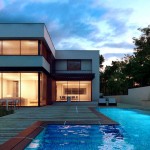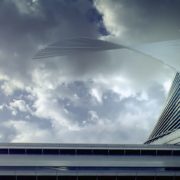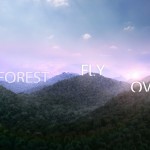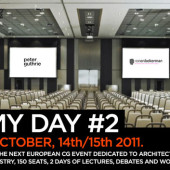Forest Fly Over, Part 2
Part 2 of the 3 parts in depth tutorial series – “Forest Fly Over”, In this part, Javier Pintor will guide you through the process of creating a the 3d studio max forest scene. Modeling the terrain, scattering the trees on top of it and rendering out the frames to later be composited using After Effects.


Author: Javier Pintor
Javier Pintor has recently finished six months of 3d archviz school and work on preparing his portfolio. He has written several times for this blog and now I’m happy to present his 3 part Forest Fly Over Tutorial.
Tutorial Details, Part 2.
Software: 3D Studio Max, MultiScatter
Difficulty: Intermediate
Completion Time: 1 hour (est.)
Resource Files Available at the Shop.
This is the continuation of Forest Fly Over, Part 1. We finished the Photoshop prep, and now go into creating the environment inside 3dsmax. First I’ll show the finished animation once more, just so you can get into the mood before diving into the details.
And now, lets start…
4. Creating the environment in 3ds Max
Now that we have all the textures and images needed, we can proceed with the creation of the 3d environment – The terrain, scattering of the trees, camera animation setup, etc.
One thing to point out is that I work in Linear Workflow exclusively. There isnt any advantage in this for this specific project, but I always work like that, so here is an image showing my Gamma/LUT setup. You can find this option under Customize/Preferences…
4.1. Modeling the terrain and trees
4.1.1. The Terrain
Before we start modeling the terrain, we need to configure some 3dsmax parameters. Go to Rendering/Render Setup… then scroll down in the Common tab to Assign Renderer and choose V-Ray Renderer. Then go to Customize/Unit Setup… then press System Unit Setup and set the unit to meters.
Now let’s set the time configuration, go to the time controls, and press the Time Configuration button, a new window will pop-up. I’m going to set a 10 seconds animation at 30 fps, so 300 frames (you can use another frame rate if you wish).
For the terrain, create a 5000×5000 plane with 500 segments in both width and length and apply a Displace modifier from the modifier list. Go to the material editor and put the displace.jpg bitmap in some slot of a clean material, (I blurred the map up to 10.0 because it was to crispy for my taste, you can skip this step if you don’t like it). Drag and drop the bitmap to the Map button in the Displace modifier, set the Strength to 250.
The terrain looks pretty decent at the moment, but the mesh is to dense so let’s add a ProOptimizer modifier, hit Calculate and let it think for few seconds, once finish set the Vertex % to 5.0, below you can see the statistics before and after.
With this method we lower the density of the mesh while keeping the details of the displace. You can now save the progress and let’s go for the trees.
4.1.2. The Trees
Create a plane of roughly 20 x 15, move the pivot point to it’s bottom edge and duplicate it as a copy 6 times, to move the pivot go to the Hierarchy panel and press Affect Pivot Only, press it once again when finished to exit pivot mode. Convert all the planes to Editable Poly.
Open the material editor, click Get Material and select Multi/Sub-Object, set the numbers to 7. Click in the first material and change it to a VRayMtl by clicking in Standard. In the material parameters go to Maps dropdown menu, in the Diffuse slot load the tree_1.png and change the Filtering from Pyramidal to None. Go back to the Maps menu and click and drag the Diffuse map to the Opacity map to copy it. In the Opacity map change the Mono Channel Output from RGB Intensity to Alpha. Apply the material to all of the planes and press the Show Map in Viewport button.
Go back to the Multi/Sub-Object menu, copy the first material into the other six slots and replace the bitmaps sequentially to have a different tree per ID. Next we need to change the Material IDs of every plane object by selecting each plane, go to Element selection in the Modify panel and assign a different number from 1 to 7 under the Polygon: Material IDs dropdown menu.
Now that we have the tree material properly assigned, select all the plane objects, click the Rotate button and change the selection to Pivot Point Center, (In the following picture I used Alt + RMB and set the Coordinates to Local which in this case produce the same result) hold Shift button and copy rotate 90 degree in Z axis, now we can see why it was important to center the tree trunk to the canvas inside Photoshop.
4.2. Creating the camera and it’s path
Go to the left view and create a Spline Line of approximately 700 meters long, (is a rough approximation to what I did, you can actually make it as long as you want) with a soft bend at the beginning. Then go to Cameras and create a VRayPhysicalCamera from the top view, try to align the target to the camera as much as you can. With the camera still selected go to Animation/Constraints/Path Constraint and click in the spline line, the camera will move to the beginning of the spline and an animation will be created.
In the next picture you can see the camera parameters used. Remember to un-tick the Targeted option.
Next you can go to the last frame of the timeline, hit Auto Key and rotate the camera vertically till achieve a comfortable framing, when done, hit Auto Key button once again, in the picture you can see I moved the X rotation axis, this is because I had Local Coordinates still active.
At any moment if you are not happy with the camera position, you can freely move the spline or modify its shape and the camera will follow along.
4.3. Tree scattering and render setup
4.3.1. Tree Scattering
It’s time to for some optimization before we scatter the trees all over the terrain, but first let’s give some format to the camera. Go to Rendering/Render Setup… and under Common tab, Output Size, choose 35mm Anamorphic (2.35:1) and set the width to 1280. Close the window and from the camera view press Shift + F to activate the Show Safe Frames option.
Select the terrain object, (if you didn’t collapse the terrain before, now is a good moment) go to Polygon selection, un-tick Ignore Backfacing if its on, and from the frame 0, make a rectangular selection covering all the camera viewport, go to Edit/Select Invert and press Delete.
We are ready to scatter the trees.
I used the plugin MultiScatter, if you are familiar with its interface there is nothing to mention, the following picture is self-explanatory, the hidden menus remain intact. You can also do the same with most other scatter plugins or 3dsmax own internal particle system.
4.3.2. Render Setup
Now we can do some test render to see how it looks what we have done so far. Go to Rendering/Render Setup… and in the V-Ray tab let’s turn on V-Ray Frame Buffer, change Image sampler type to Fixed, antialiasing to Quadratic (this is a personal preference, so use what you like the most) In the Fixed image sampler subcategory set the subdivisions to 3. Under Environment dropdown turn on GI Environment and, under Color mapping, type Linear multiply, Gamma 2.2 and check Don’t affect colors.
Under Indirect illumination tab, turn on GI, Irradiance map as a Primary bounces and None as a Secondary bounces, we will save some calculation time and for this specific animation is not really needed. Select Very low preset under the Irradiance map subcategory.
Finally, go to Render Elements tab, click Add … and choose VRayZDepth, this will help to produce environment fog with no extra time. Under ZDepth parameters, set zdepth max to 2000, (this value may vary depending of the size of your model, so make sure to measure first the terrain)
Hit the render button at let’s see what we have got, don’t forget to activate de sRGB button in the VFB window. In my case the render time took about 1 minute. At this point one think I don’t like is the huge color variation between trees, I wanna even them a little bit, so let’s go to the Material editor and assign a Color Correction map to the diffuse slot of those trees you may think can be causing that huge color variation (of course feel free to skip this step if you are happy with the actual result)
In the next picture we can see the before and after the color variation and its setup for one of the trees.
When happy with the look of the mountains, we can proceed to the GI calculation. Open once again the Render Setup. Go to Common tab and tick Active Time Segment and set Every Nth Frame to 5. In the V-Ray tab, under Global switches, tick Don’t render final image because we aim for the GI information only. Lastly in the Indirect illumination tab and under Irradiance map, set the Mode to Multiframe incremental, tick Auto save, Switch to saved map, and indicate a path in your project folder for the Irradiance map file to be stored.
You can hit render and prepare coffee.
Once GI calculation is finished and stored, back to Render Setup, set Every Nth Frame back to 1, un-tick Don’t render final image, and make sure the Mode under Irradiance map dropdown changed from Multiframe incremental to From file and the path is specified under.
One more thing to do before the final render is setup a saving method. Go to Frame buffer submenu under V-Ray tab, tick Render to V-Ray raw image file, click Browse… and specify the folder where to store the final sequence. I named it frame_.exr where the underscore will be followed by a 4 digit number indicating the frame (I think it makes sense), also chose OpenEXR as a file type and un-tick EXR Use 32-bit output. Why? Because 16bit is quite enough in this case and the file size will be much smaller than a 32bit.
Hit render and drink the coffee, or two… or 300.
Tutorial Resource Files
This tutorial comes with a pack that you can grab from the shop. It contains the full 3 part tutorial, two 3dsmax 2010 scene files setup with MultiScatter or Particles and ready to render with V-Ray, final animation, after effects composition file and the original and postworked photos used to create the trees and sky.




































Thank you very much Jav.. I will try this tonight 🙂 It is exactly what i was looking for my current learning project (not animated thogh) but i can learn new tricks here..
Thanks for ur efforts and time.. also thanks to Ronen 🙂
Thanks, I hope you will find it useful, and if have some questions, I’ll be glad to answer.@Dollmaker
@jpintor
http://img208.imageshack.us/img208/4268/76539840.jpg
This is what I come up with so far 😉
Very nice looking, adding some distance fog or haze will improve it, I do something like that in the third part. @Dollmaker
@jpintor
Thanks.. ya waiting for 3rd part.. I added fog using zdepth.. Saw Ronens tutorial but its not complete.. so did what i could 🙂
I just wonder what hardware did Javier used ?
I have an i7 2600, 16GB Ram and a GTX460 1GB.
Very usefull. Thanks!
File http://cdn.ronenbekerman.com/wp-content/uploads/2011/10/GammaSetup1.png NOT FOUND 🙁
Yep, can’t see the picture of your gamma settings.
Also, did you use only ONE GI pass with irradiance? Didn’t you use a second GI pass with brute force or something?
@daviusddl I’ll fix it, but basically Gamma is set to 2.2 with all both affect check-boxes on. Input at 2.2 and Output at 1.0
Hello, I found not much differences doing secondary bounces in this specific scene, thats why I left off the second GI engine. Also I save a lot of calculation time.@daviusddl
And about my gamma settings, this article by David Fleet explains it really well.
http://www.davidfleet.com/tutorials/linear-workflow@daviusddl
Hey i Am getting Jitter While rendering in Batch and Low On Brightness…
Any Solutions?
Hmmm, can be due to many reasons, could you elaborate a little bit? maybe you saved the gi and then change some light properties or modificate the scene or meshes. As I said can be quite a few reasosn. @ArpitNanda